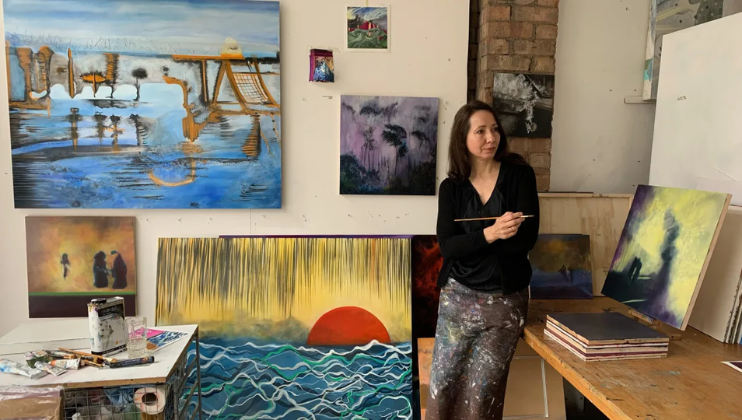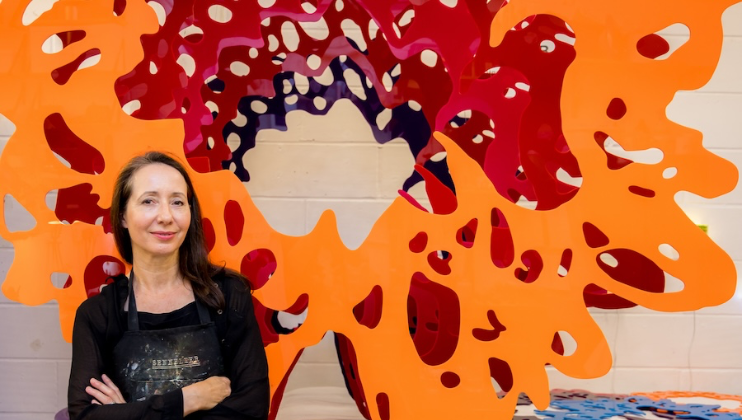Interview with artist Helen Brough
Culture Calling spoke to British artist Helen Brough, whose sculpture Heart of the Dahlia forms a centrepiece at this autumn’s Affordable Art Fair

Hi Helen! What's your story as an artist?
I started painting as a child and then went to art school. I was fortunate enough to be a Rome Scholar in Rome, and from there I applied for an art residency program in Omaha, Nebraska in the USA. So stayed in America for many years and in New York and then back to London in 2010.
What’s the difference between creating for an affordable market and creating much bigger pieces for big-spending buyers?
They are different and similar. I think the thing with the affordable is that you tend to be very free. You know, the affordable work is the initial works on paper, the small paintings, the trial outs, the things that you're just experimenting with.
When you present to a corporation, when they want a huge collection of work they want models, they want sizes…they want a real brief, and they want to have it sewn up before you arrive, really. So I think that's the difference, but all those pieces start with small drawings - little watercolours.
Your sculpture, Heart of the Dahlia, is on display at the Affordable Art Fair. What can you tell us about it?
It's a quarter-inch acrylic that has been laser cut, and it's very big! It's two metres by three metres, and it's hung in ten sections that come together.
It's a flower, and it came from a series that was using the English and Italian words for ‘fury’. It was instigated by a lot of unrest, I think, over this whole pre-COVID, COVID, post-COVID period, and just looking at those two words. You can think of it as a peace flower, or you can think of it as concentric shapes receding - it's got this one little different play in the front that we slightly changed for the Affordable Art Fair - it's going to be slightly mirrored so that you'll be reflecting yourself while you're looking at it.
Let's hope somewhere out there someone is looking for a really large sculpture they want to put in their lobby!

You work across a few different mediums. How, and at what point, do you decide which medium to use for any given piece?
I think everything starts with drawing. So everything probably starts [as] just a little sketch. Sometimes it depends what exhibition you've got coming up, or what you've been doing, because sculpture is expensive, you know. Paper is cheap, but to do a large sculpture, it has to be funded. That's just the reality of where I am as an artist, really.
I think some things I try as paintings and they don't work and they might just work as a sculpture or something small, like working glass as a miniature piece. I've been quite consciously trying to answer that question myself, actually. It's like, what is this going to be? And I think that's the worst thing you can say as an artist, because then you put pressure on yourself.
It's interesting because you tend to miss a lot of stuff. Sometimes it takes someone else coming into the studio and saying: “what's that? Why isn't that a big painting? What's wrong with that one? Why have you done that one and not that one?”
A lot of times I feel like I make wrong decisions. You look back and think: ‘why didn't I make that?’ Maybe it was one that touched you a little bit too deeply or it was slightly uncomfortable. I think it's a constant battle - and also what's great then is studio visits; that's where the gallerist comes in, because I think it's hard to navigate sometimes yourself. And then when your mood changes, you look at something again and think: ‘actually, that's really good or actually that is awful…let's just, you know, throw that one away…’
You have spoken about loyalty and commitment in the art world; how they can be hard to come by - can you say more about that?
Well, I think the art world is an echo of the world, and there's loads of different commitments that happen. There's the artist in the gallery - I'm very lucky with Art Movement because I feel I'm supported, [and] I can be quite open - I should say, Art Movement is an original AAF gallery and we have also collaborated on ideas and she has given me feedback at every stage along the way, from the watercolours and sketches to the large oil paintings. She has helped curate the best show possible for me at this very special 25th anniversary!
There's a question of trust - they're trusting me to work, I'm trusting them to try and show my work to as many people as want to see it. Then there's the commitment between the collectors and the artists. You know, I've got quite a few collectors that have collected my work for 30 years, and one of them has around 50 pieces from a whole timeline, which is lovely because you feel that they grow with you and that they're supporting you through different phases.
Artists and artists, that's a really important thing; connection, because a lot of it is collaborative, a lot of it is studio visits from your mate coming around and having a cup of tea and just being very honest with you, or helping you through things. And Then I think, in some ways, the question can be applied to yourself. As an artist, you have to be really committed to yourself.
Then, on the other side, there's the critics and the curators, because they have their own trust and relationship. So it's broken into many parts. I think you go through periods where perhaps some things aren't as good as others…I think it's hard to get it all to be brilliant…You have to feel that you can voice your concerns.
You have also worked in New York, and in mainland Europe; what defines or distinguishes the London art scene?
It's interesting because I just went to Frieze yesterday and, you know, it's quite incredible how that has taken off - I mean, it's just amazing. I think London has a lot more historical influence. The YBAs (Young British Artists) had forged an amazing scene. There were loads more galleries. Obviously today you've got the Tate, the National Gallery, the Royal Academy… you have these institutions, but you also have a very good contemporary scene that, I think, has grown so much in the last 20 years.
New York has always been a bit more modern, a bit more cutting edge, and a bit more cut-throat [as an artist]! You've got the MoMA, the Guggenheim, the movements that took place in America - abstract expressionism, minimalism…it's post-war, really. Obviously, New York is much more post-war.
In somewhere like Budapest, I think it's a much more local scene, and you're dealing with people from Central Europe a lot more. I mean, Paris has changed a lot because of Brexit, because suddenly a lot of galleries need to have a big gallery in Europe for, you know, shipping and customs and all that stuff.
London is a juggernaut, and increasingly so; actually, in the last five years, there's been a lot of big galleries who've been open in New York for a long time, perhaps they're in Hong Kong now, and they say “we've got to have somewhere in London”.
How might an interested crowd dive into the art scene in London?
Well, the best way to do it is to go somewhere like the Affordable Art Fair!
Go to one of the galleries and buy a painting because then you start to have a relationship with the gallerist and they can invite you to different events. You can get on different mailing lists for things like Frieze or the Other Art Fair, or the British Art Fair. You could start to see lots of different artworks, although I do personally know a lot of collectors who have been loyal to me for many years.
If you're starting a collection it's best just to find a gallery where you enjoy their work and you feel you can talk to the gallerist, because they're definitely what they're there for.
The Affordable Art Fair takes place in Battersea from the 16th to the 20th of October, and Helen Brough will be exhibiting with Art Movement – pop by and say hi!